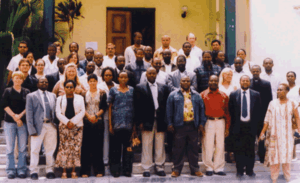Pigtrop - Le centre d'information sur l'élevage porcin et les filières porcines des pays du Sud
5th General Assembly of the Cysticercosis Working Group in Eastern and Southern Africa
Medical and veterinary doctors, social scientists and agricultural researchers meet to carry forward the fight against cysticercosis, a neglected and fatal disease of the poor
An international forum in Mozambique against cysticercosis
The fifth general assembly meeting on cysticercosis/taeniosis was held at the Faculty of Medicine, Eduardo Mondlane University, in Maputo, Mozambique, from 11 – 13 October 2007. The meeting was organised by the Cysticercosis Working Group in Eastern and Southern Africa (CWGESA) in cooperation with the Medical and Veterinary Faculties of Eduardo Mondlane University in Mozambique and the WHO/FAO Collaborating Centre for Parasitic Zoonoses in Denmark with support from DBL – Centre for Health Research and Development, Denmark and the Global Alliance for Livestock Veterinary Medicines (GALVmed) based in Edinburgh, Scotland. Local support in Maputo was provided by Nestlé, Medis Farmaceutica, M-cel and the Golden Travel Agency. The CWGESA was established in 2002 to promote communication, collaboration and coordination of integrated research and control activities to combat cysticercosis, a serious and sometimes fatal disease transmitted between pigs and people by the zoonotic tapeworm Taenia solium. The fifth CWGESA General Assembly provided a forum to reflect on the progress of implementing the Regional Action Plan for Combating Cysticercosis in Eastern and Southern Africa that was formulated during the International Action Planning Workshop on Taenia solium Cysticercosis/Taeniosis held in Arusha, Tanzania five years ago.
Meeting participants provided updates on the status of porcine and human cysticercosis in the 10 endemic eastern and southern African countries represented at the meeting as well as in Madagascar and Burkina Faso, including current and planned research and control efforts, on the Global Campaign for Combating T. solium cysticercosis, and on the latest developments in diagnostic tests and vaccines and strategies for their delivery. Opportunities for linking cysticercosis research and control initiatives with initiatives relating to schistosomiasis and other neglected tropical diseases, African swine fever and pig production and marketing were explored. In addition, the meeting included a workshop on risk analysis to highlight a risk based approach to cysticercosis/taeniosis control. Implementation of the Regional Action Plan for Combating Cysticercosis in Eastern and Southern Africa formulated in Arusha in 2002 was discussed and the plan was updated to include, among other things, a focus on pig production and marketing. Participants were informed that a CWGESA website is now available (www.cwgesa.org). It was concluded that cysticercosis remains a neglected zoonosis in eastern, southern and other parts of Africa and that relentless efforts will be required to alter that situation.
Background information
Taenia solium is a parasite transmitted between humans and pigs. This zoonotic disease forms larval cysts in humans and pigs that can lead to epilepsy and death in humans, reduces the market value of pigs and makes pork unsafe to eat. People become infected with the adult tapeworm form of the parasite (taeniosis) by eating infested raw or undercooked pork. Large numbers of the eggs of the tapeworm are shed in the infected person’s stool and can be ingested by free-roaming pigs if people defecate outdoors. Pigs develop the immature larval form of the parasite (cysticercosis) with hundreds to thousands of small cysts, commonly called ‘pork measles’, forming in their muscles, heart and brain, rendering the pork unfit for consumption. Pigs thus affected usually show no signs of disease. People can also become infected with the cystic larval form of the parasite by ingesting T. solium eggs either from direct contact with a human tapeworm carrier or from contaminated food and water - thus one does not need to raise pigs or consume pork to become infected with cysticercosis! In humans the cysts often develop in the brain, causing a condition called neurocysticercosis, which can cause severe headaches, epileptic seizures and sometimes death. Neurocysticercosis is considered to be the most common preventable cause of epilepsy in the developing world, rendering people incapacitated and unproductive, and sometimes leading to fatal accidents as a result of seizures. Although theoretically easy to control and declared eradicable cysticercosis remains neglected in most endemic countries due to lack of information and awareness about the extent of the problem, suitable diagnostic and management capacity, and appropriate prevention and control strategies.
En savoir plus
CWGESA internet website : http://www.cwgesa.org
Commentaires
CIRAD © 2007 (Tous droits réservés) - Informations légales - Page mise à jour : 11/12/2007
